
 |
Flying in the Super
Sabre
An exhilarating
experience
by Bob
Violett |
|
|
It has been 35 years since the U.S. NAVY allowed me
to fly the A-4 Skyhawk and the F-8 Crusader.
 
One can get very busy with life's other challenges
and assign those experiences to the past - pleasant memories, but
history.
That is what I thought until the noon-time show at
last year's Heart of Ohio Jet Scramble when Dean Cutshall thrilled the crowd
with his F-100F Super Sabre afterburner fly-bys. I asked Terry Nitsch, "How
does one get a ride in the back seat?" Big "T" made the arrangements and I got
my opportunity at the 2003 event.
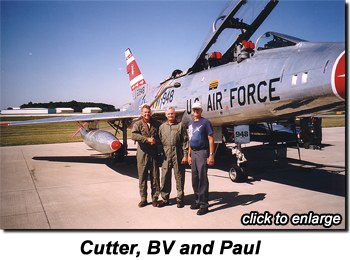 A Cessna 172 ride from Columbus to Mercury
Aviation at Ft. Wayne, Indiana Airport (and return) was also arranged to
minimize my time away from the Jet Scramble. A Cessna 172 ride from Columbus to Mercury
Aviation at Ft. Wayne, Indiana Airport (and return) was also arranged to
minimize my time away from the Jet Scramble.
Dean "Cutter" Cutshall (also a former Navy A-4 pilot)
graciously greeted my arrival and provided an hour-long briefing on the flight,
instruction on flight gear use, cockpit procedures, etc. His emphasis was on my
enjoyment of the flight. My emphasis was to try not to screw anything up, after
all it has been 35 years.
In an effort to prepare, I borrowed an F-100F - 1
manual from neighbor and friend, Bob Lampke, who flew the "Hun" in the Air
Guard at Ft. Wayne some years past.
A few days of studying the "dash one" does not fully
prepare one, but at least I gained some knowledge of the airframe, power
system, hydraulics, electrical, and the ejection seat capabilities. Dean is in
control of all that stuff, but it is nice to know the basics.
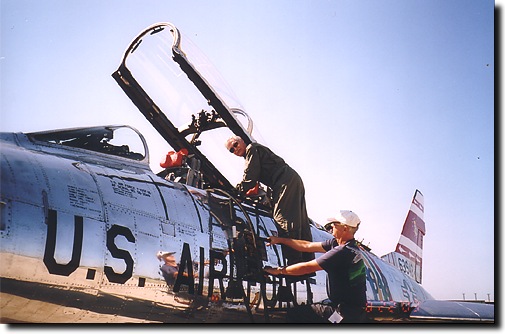
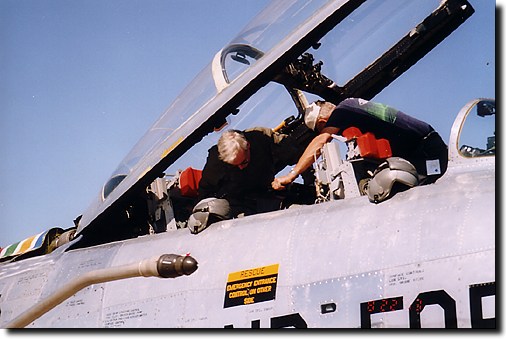

View of Dean's
office. |

The start cart
provides air to start the engine on Dean's signal to Paul. |

Dean has the J57 started and is
going through control checks with Paul (on the ground) prior to
taxi. |
|
SO HOW WAS
IT? |
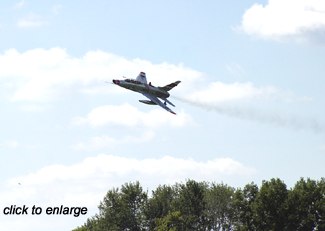
This is about a second before the loud bang of the A/B
on a fly-by at the Darby Dan Airport in Columbus, Ohio. The black smoke
disappears upon burner light off. |
It was worth every penny. The ability to
accelerate rapidly while applying 3+ G's in a steeply banked pull-up is unique
to an afterburner equipped jet fighter. The loud bang and plume of fire from
the exhaust that are signals of burner engagement to ground observers,
translates only as a silent thrust backwards in the ejection seat for the
pilots. |
|
Pulling G's, of course, pushes one into the
seat bottom cushion and makes your arms and head feel heavy. The combination of
lateral and vertical G's is an exhilarating experience. While 6 to 7 positive
G's are available from the airframe, Dean takes it easy on his back seat
passengers. |
STICK
TIME
35 years away from this type of flying can make one a
bit rusty, so I was not the smoothest dude on the controls. At least, I did not
bend any metal or make Dean sick.
The F-100 is known for its adverse yaw affect with
aileron input, so rudder use is paramount. Even a simple aileron roll is made
with generous foot pressure on the appropriate rudder pedal.
The "Hun" is really in its element above 300 kts, the
control response and stability are best above that speed, reflecting the design
capability for supersonic jets of that era. Pitch and yaw stabilization systems
are employed to help smooth things out.
Like all jet fighters, when it is "down and dirty" in
the landing pattern, it is a power-up affair, about 85-90% rpm to maintain.
This is where the model and the real thing are most similar, you just don't
reduce power more than a fraction until over the "numbers" and setup to
flare.
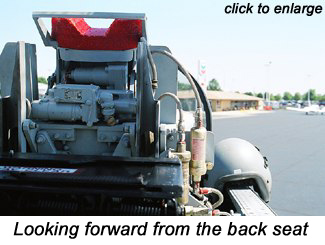 "Cutter" coached me through 3 approaches
and go-arounds at the Fort Wayne airport. Landing pattern speed is 230 knots
and half flaps. The speed at the "90" and on final is a function of weight
(fuel remaining). As full flaps are selected there is a slight trim change and
need to adjust power. "Cutter" coached me through 3 approaches
and go-arounds at the Fort Wayne airport. Landing pattern speed is 230 knots
and half flaps. The speed at the "90" and on final is a function of weight
(fuel remaining). As full flaps are selected there is a slight trim change and
need to adjust power.
Visibility from the back seat is great during the
approach turn but when I rolled out on final, the runway all but disappeared
and I had a great view of the back of Dean's ejection seat making the go-around
an instrument maneuver.
Dean then put on quite an airshow for the Fort Wayne
locals with 4 more afterburner low passes.
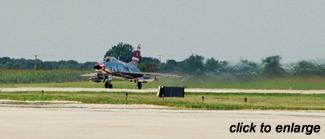
The final nose high touchdown speed was about 160
kts, and yes, you can feel the drogue chute deploy, followed by some serious
wheel braking.
Communications between the fore and aft cockpits is
via a "Hot Mike" system in the oxygen mask, so it stays securely clipped to
both sides of your helmet even during the taxi back. When Dean broadcasts
"Clear Canopy", you make sure your arms and hands are close in and the huge,
massively reinforced clam shell slowly rises. It was a beautiful, clear,
80° day so the fresh air and breeze from the taxi speed was welcomed, but
of course, it was a sign that the fun was about to end.
Now you can rest your arms on the canopy rails,
release one side of the O² mask and wave to the ground personnel and feel
real cool - a fighter pilot again and it only required 1,200 gallons of
fuel.
Just like getting strapped into the rather complex
harness system of the ejection seat, disembarking the Hun required some help
from Paul Zwick, the maintenance chief of this former war machine. Paul's Air
Force career prepared him for this mission and it is his daily delight to keep
Buz #63948 in perfect condition.
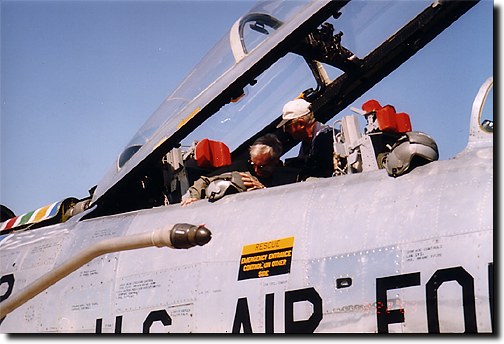
Many thanks to Dean (Cutter) Cutshall, Paul Zwick,
and Larry Brown (also a former F-100 guy who took most of these photos) for a
most rewarding and exhilarating experience.
Thanks also to Terry Nitsch and the members of the
T.O.R.K.S. club who handled all of the arrangements and logistics to make my
ride so easy to accomplish.
If you would like to read more about this one-of-two
flying F-100's in the world, there was a great article in the October 2000
issue of Flight Journal, an Air Age Publication. See www.airage.com.
The story of the F-100F at war is best captured in a
book called "Misty" by Major General Don Shepperd USAF (Ret.) -
www.mistyvietnam.com. It is a compilation of stories from the surviving members
of the "Misty FACs" or Fast Forward Air Controllers during the Vietnam War. The
155 Mistys rank at the top of the bravest, most "shot at" fighter pilots of
that war - and that statement is from an 83 mission NAVY pilot of the same era
(1967).

And now back to the daily grind.
F-100F Specifications:
- Span = 38' 9"
- Length = 52' 6"
- Height = 16' 3"
- Weight = 31,800 lbs (clean wing)
- Engine = J57-21
- Thrust = 10,200 lbs at military thrust
 16,000 lbs with afterburner (combat rated
thrust) 16,000 lbs with afterburner (combat rated
thrust)

|